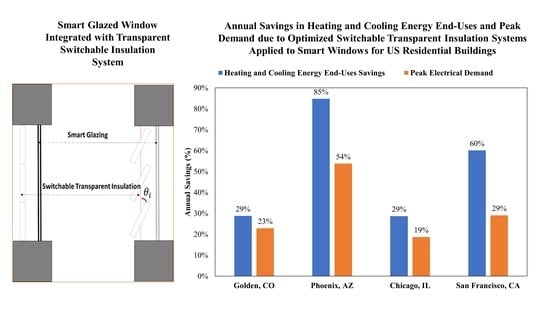Optimal Control Strategies for Switchable Transparent Insulation Systems Applied to Smart Windows for US Residential Buildings
Abstract
1. Introduction
2. Switchable Insulation Description
3. Building Energy Model Description
4. Development of Optimized Control Schemes
4.1. Genetic Algorithm Simulation Environment
4.2. Optimization Cost Function
- ■
- Ecooling: Cooling thermal loads for each time-step
- ■
- Eheating: Heating thermal loads for each time-step
- ■
- ratecooling: Cost of electricity for cooling utility (set to be $0.1/kWh in this study)
- ■
- rateheating: Cost of natural gas for heating utility (set to be $0.03/kWh in this study)
5. Discussion of Results
5.1. Impact of Optimization Sequence
5.2. Impact of Seasons
5.2.1. Representative Day for the Swing Season
5.2.2. Representative Day for the Summer Season
5.2.3. Representative Day for the Winter Season
5.2.4. Summary of Season’s Impacts
5.3. Impact of Climate
5.3.1. San Francisco, CA, USA
5.3.2. Phoenix, AZ, USA
5.3.3. Chicago, IL, USA
6. Sensitivity Analyses
6.1. Impact of Optimization Time-Step
6.2. Impact of Population Size
6.3. Impact of R-Value and SHGC
6.4. Impact of WWR
6.5. Impact of Internal Loads
7. Summary and Conclusions
Author Contributions
Funding
Institutional Review Board Statement
Informed Consent Statement
Data Availability Statement
Conflicts of Interest
Nomenclature
| ASHRAE. | American Society of Heating, Refrigerating and Air-Conditioning Engineers |
| Btu | British thermal unit |
| CDD | Cooling degree days using 18 °C base temperature [°C-days/year] |
| COP | Coefficient of performance for an air conditioning system |
| EC | Electrochromic |
| GA | Genetic Algorithm |
| GHG | Greenhouse gas |
| HDD | Heating degree days using 18 °C base temperature [°C-days/year] |
| HVAC | Heating ventilation and air conditioning |
| HVAC load | Heat transferred to or from the HVAC system [kWh] |
| IECC | International Energy Conservation Code |
| LC | Liquid crystal |
| MPC | Model predictive control |
| MSA | Monolithic silica aerogels |
| nvar | Number of variables |
| PDLC | Polymer dispersed liquid crystal |
| PSO | Particle swarm optimization |
| R-value | Thermal resistance value [m2 K/W] |
| RSI | Thermal resistance in SI unit [m2 K/W] |
| RC | Resistor–Capacitor |
| SHGC | Solar heat gain coefficient |
| SIS | Switchable insulation system |
| SPD | Suspended particle device |
| STIS | Switchable transparent insulation system |
| U-value | Thermal transmittance value [W/m2 K] |
| WWR | Windows-to-wall ratio |
References
- US Department of Energy. An Assessment of Energy Technologies and Research: Increasing Efficiency of Building Systems and Technology; US Department of Energy: Washington, DC, USA, 2015.
- Pérez-Lombard, L.; Ortiz, J.; Pout, C. A review on buildings energy consumption information. Energy Build. 2008, 40, 394–398. [Google Scholar] [CrossRef]
- U.S. Energy Information Administration. Available online: https://www.eia.gov/energyexplained/us-energy-facts/ (accessed on 17 May 2021).
- Cho, S.-H.; Shin, K.-S.; Zaheer-Uddin, M. The effect of slat angle of windows with venetian blinds on heating and cooling loads of buildings in South Korea. Energy 1995, 20, 1225–1236. [Google Scholar] [CrossRef]
- Feng, W.; Zou, L.; Gao, G.; Wu, G.; Shen, J.; Li, W. Gasochromic smart window: Optical and thermal properties, energy simulation and feasibility analysis. Sol. Energy Mater. Sol. Cells 2016, 144, 316–323. [Google Scholar] [CrossRef]
- Ye, H.; Meng, X.; Xu, B. Theoretical discussions of perfect window, ideal near infrared solar spectrum regulating window and current thermochromic window. Energy Build. 2012, 49, 164–172. [Google Scholar] [CrossRef]
- Hernandez, T.S.; Alshurafa, M.; Strand, M.T.; Yeang, A.L.; Danner, M.G.; Barile, C.J.; McGehee, M.D. Electrolyte for Improved Durability of Dynamic Windows Based on Reversible Metal Electrodeposition. Joule 2020, 4, 1501–1513. [Google Scholar] [CrossRef]
- Sbar, N.L.; Podbelski, L.; Yang, H.M.; Pease, B. Electrochromic dynamic windows for office buildings. Int. J. Sustain. Built Environ. 2012, 1, 125–139. [Google Scholar] [CrossRef]
- Lee, E.; Yazdanian, M.; Selkowitz, S. The Energy-Savings Potential of Electrochromic Windows in the US Commercial Buildings Sector; Building Technology & Urban Systems Division: Berkeley, CA, USA, 2004. [Google Scholar]
- Nundy, S.; Mesloub, A.; Alsolami, B.M.; Ghosh, A. Electrically actuated visible and near-infrared regulating switchable smart window for energy positive building: A review. J. Clean. Prod. 2021, 301, 126854. [Google Scholar] [CrossRef]
- Ghosh, A.; Norton, B.; Mallick, T.K. Influence of atmospheric clearness on PDLC switchable glazing transmission. Energy Build. 2018, 172, 257–264. [Google Scholar] [CrossRef]
- Hemaida, A.; Ghosh, A.; Sundaram, S.; Mallick, T.K. Evaluation of thermal performance for a smart switchable adaptive polymer dispersed liquid crystal (PDLC) glazing. Sol. Energy 2020, 195, 185–193. [Google Scholar] [CrossRef]
- Shaik, S.; Gorantla, K.; Ramana, M.V.; Mishra, S.; Kulkarni, K.S. Thermal and cost assessment of various polymer-dispersed liquid crystal film smart windows for energy efficient buildings. Constr. Build. Mater. 2020, 263, 120155. [Google Scholar] [CrossRef]
- Kumar, S.; Hong, H.; Choi, W.; Akhtar, I.; Rehman, M.A.; Seo, Y. Acrylate-assisted fractal nanostructured polymer dispersed liquid crystal droplet based vibrant colored smart-windows. RSC Adv. 2019, 9, 12645–12655. [Google Scholar] [CrossRef]
- Sun, H.; Xie, Z.; Ju, C.; Hu, X.; Yuan, D.; Zhao, W.; Shui, L.; Zhou, G. Dye-Doped Electrically Smart Windows Based on Polymer-Stabilized Liquid Crystal. Polymers 2019, 11, 694. [Google Scholar] [CrossRef]
- Al-Hussein, M.; Elezzabi, A.; Dhar, R.S. Smart window technologies: Electrochromics and nanocellulose thin film membranes and devices. SDRP J. Nanotechnol. Mater. Sci. 2016, 1. Available online: http://www.openaccessjournals.siftdesk.org/articles/pdf/Smart-Window-Technologies-Electrochromics-and-Nanocellulose20160330234049.pdf (accessed on 17 May 2021).
- Liu, S.; Zhang, D.; Peng, H.; Jiang, Y.; Gao, X.; Zhou, G.; Liu, J.-M.; Kempa, K.; Gao, J. High-efficient smart windows enabled by self-forming fractal networks and electrophoresis of core-shell TiO2@SiO2 particles. Energy Build. 2021, 232, 110657. [Google Scholar] [CrossRef]
- Ghosh, A.; Norton, B. Optimization of PV powered SPD switchable glazing to minimise probability of loss of power supply. Renew. Energy 2019, 131, 993–1001. [Google Scholar] [CrossRef]
- Gonçalves, H.M.R.; Pereira, R.F.P.; Lepleux, E.; Carlier, T.; Pacheco, L.; Pereira, S.; Valente, A.J.M.; Fortunato, E.; Duarte, A.J.; Bermudez, V.D.Z. Nanofluid Based on Glucose-Derived Carbon Dots Functionalized with [Bmim]Cl for the Next Generation of Smart Windows. Adv. Sustain. Syst. 2019, 3, 1900047. [Google Scholar] [CrossRef]
- Kim, J.-H.; Hong, J.; Han, S.-H. Optimized Physical Properties of Electrochromic Smart Windows to Reduce Cooling and Heating Loads of Office Buildings. Sustainability 2021, 13, 1815. [Google Scholar] [CrossRef]
- Nundy, S.; Ghosh, A. Thermal and visual comfort analysis of adaptive vacuum integrated switchable suspended particle device window for temperate climate. Renew. Energy 2020, 156, 1361–1372. [Google Scholar] [CrossRef]
- Al-Masrani, S.M.; Al-Obaidi, K.M. Dynamic shading systems: A review of design parameters, platforms and evaluation strategies. Autom. Constr. 2019, 102, 195–216. [Google Scholar] [CrossRef]
- Firląg, S.; Yazdanian, M.; Curcija, C.; Kohler, C.; Vidanovic, S.; Hart, R.; Czarnecki, S. Control algorithms for dynamic windows for residential buildings. Energy Build. 2015, 109, 157–173. [Google Scholar] [CrossRef]
- Van Moeseke, G.; Bruyère, I.; de Herde, A. Impact of control rules on the efficiency of shading devices and free cooling for office buildings. Build. Environ. 2007, 42, 784–793. [Google Scholar] [CrossRef]
- Shen, H.; Tzempelikos, A.; Atzeri, A.M.; Gasparella, A.; Cappelletti, F. Dynamic Commercial Façades versus Traditional Construction: Energy Performance and Comparative Analysis. J. Energy Eng. 2015, 141, 04014041. [Google Scholar] [CrossRef]
- Knudsen, M.; Petersen, S. Economic model predictive control of space heating and dynamic solar shading. Energy Build. 2020, 209, 109661. [Google Scholar] [CrossRef]
- Cort, K.A.; McIntosh, J.A.; Sullivan, G.P.; Ashley, T.A.; Metzger, C.E.; Fernandez, N. Testing the Performance and Dynamic Control of Energy-Efficient Cellular Shades in the PNNL Lab Homes; Pacific Northwest National Lab (PNNL): Richland, WA, USA, 2018. [Google Scholar]
- Tzempelikos, A.; Shen, H. Comparative control strategies for roller shades with respect to daylighting and energy performance. Build. Environ. 2013, 67, 179–192. [Google Scholar] [CrossRef]
- Alva, M.; Vlachokostas, A.; Madamopoulos, N. Experimental demonstration and performance evaluation of a complex fenestration system for day-lighting and thermal harvesting. Sol. Energy 2020, 197, 385–395. [Google Scholar] [CrossRef]
- Futrell, B.J.; Ozelkan, E.C.; Brentrup, D. Bi-objective optimization of building enclosure design for thermal and lighting performance. Build. Environ. 2015, 92, 591–602. [Google Scholar] [CrossRef]
- Lee, B.; Jang, Y.; Choi, J. Multi-stage optimization and meta-model analysis with sequential parameter range adjustment for the low-energy house in Korea. Energy Build. 2020, 214, 109873. [Google Scholar] [CrossRef]
- Tian, W. A review of sensitivity analysis methods in building energy analysis. Renew. Sustain. Energy Rev. 2013, 20, 411–419. [Google Scholar] [CrossRef]
- Bichiou, Y.; Krarti, M. Optimization of envelope and HVAC systems selection for residential buildings. Energy Build. 2011, 43, 3373–3382. [Google Scholar] [CrossRef]
- Kasinalis, C.; Loonen, R.; Cóstola, D.; Hensen, J. Framework for assessing the performance potential of seasonally adaptable facades using multi-objective optimization. Energy Build. 2014, 79, 106–113. [Google Scholar] [CrossRef]
- Yu, W.; Li, B.; Jia, H.; Zhang, M.; Wang, D. Application of multi-objective genetic algorithm to optimize energy efficiency and thermal comfort in building design. Energy Build. 2015, 88, 135–143. [Google Scholar] [CrossRef]
- Reynolds, J.; Rezgui, Y.; Kwan, A.; Piriou, S. A zone-level, building energy optimisation combining an artificial neural network, a genetic algorithm, and model predictive control. Energy 2018, 151, 729–739. [Google Scholar] [CrossRef]
- Shekar, V.; Krarti, M. Control strategies for dynamic insulation materials applied to commercial buildings. Energy Build. 2017, 154, 305–320. [Google Scholar] [CrossRef]
- Nguyen, A.-T.; Reiter, S.; Rigo, P. A review on simulation-based optimization methods applied to building performance analysis. Appl. Energy 2014, 113, 1043–1058. [Google Scholar] [CrossRef]
- Evins, R. A review of computational optimisation methods applied to sustainable building design. Renew. Sustain. Energy Rev. 2013, 22, 230–245. [Google Scholar] [CrossRef]
- Jaffal, I.; Inard, C. A metamodel for building energy performance. Energy Build. 2017, 151, 501–510. [Google Scholar] [CrossRef]
- Caldas, L.G.; Norford, L.K. A design optimization tool based on a genetic algorithm. Autom. Constr. 2002, 11, 173–184. [Google Scholar] [CrossRef]
- Manzan, M. Genetic optimization of external fixed shading devices. Energy Build. 2014, 72, 431–440. [Google Scholar] [CrossRef]
- Zhao, J.; Du, Y. Multi-objective optimization design for windows and shading configuration considering energy consumption and thermal comfort: A case study for office building in different climatic regions of China. Sol. Energy 2020, 206, 997–1017. [Google Scholar] [CrossRef]
- Huchuk, B.; Gunay, H.B.; O’Brien, W.; Cruickshank, C.A. Model-based predictive control of office window shades. Build. Res. Inf. 2015, 44, 1–13. [Google Scholar] [CrossRef]
- Imbabi, M.S.-E.; Elsarrag, E.; O’Hara, T.G. Dynamic Insulation Systems. U.S. Patent US20140209270A1, 31 July 2014. [Google Scholar]
- Cui, H.; Overend, M. A review of heat transfer characteristics of switchable insulation technologies for thermally adaptive building envelopes. Energy Build. 2019, 199, 427–444. [Google Scholar] [CrossRef]
- Clark, W.W.; Schaefer, L.A.; Knotts, W.A.; Mo, C.; Kimber, M. Variable Thermal Insulation. U.S. Patent US 20130081786 A1, 4 April 2013. [Google Scholar]
- Krarti, M. Dynamic Insulation Systems for Switchable Building Envelope. U.S. Patent WO/2021/021884, 4 February 2021. Volume 62, p. 29. [Google Scholar]
- Park, B.; Srubar, W.V.; Krarti, M. Energy performance analysis of variable thermal resistance envelopes in residential buildings. Energy Build. 2015, 103, 317–325. [Google Scholar] [CrossRef]
- Rupp, S.; Krarti, M. Analysis of multi-step control strategies for dynamic insulation systems. Energy Build. 2019, 204, 109459. [Google Scholar] [CrossRef]
- Menyhart, K.; Krarti, M. Potential energy savings from deployment of Dynamic Insulation Materials for US residential buildings. Build. Environ. 2017, 114, 203–218. [Google Scholar] [CrossRef]
- Dabbagh, M.; Krarti, M. Evaluation of the performance for a dynamic insulation system suitable for switchable building envelope. Energy Build. 2020, 222, 110025. [Google Scholar] [CrossRef]
- Dabbagh, M.; Krarti, M. Energy performance of switchable window insulated shades for US residential buildings. J. Build. Eng. 2021, 43, 102584. [Google Scholar] [CrossRef]
- Leung, C.; Lu, L.; Liu, Y.; Cheng, H.; Tse, J.H. Optical and thermal performance analysis of aerogel glazing technology in a commercial building of Hong Kong. Energy Built Environ. 2020, 1, 215–223. [Google Scholar] [CrossRef]
- ASHRAE, Energy Efficient Design for Low-Rise Residential Buildings, ASHRAE Standard 90.2, 2018, American Society of Heating and Air-Conditioning Engineers Inc. Atlanta, GA. Available online: https://ashrae.iwrapper.com/ASHRAE_PREVIEW_ONLY_STANDARDS/STD_90.2_2018 (accessed on 17 May 2021).
- DeForest, N.; Shehabi, A.; Selkowitz, S.; Milliron, D.J. A comparative energy analysis of three electrochromic glazing technologies in commercial and residential buildings. Appl. Energy 2017, 192, 95–109. [Google Scholar] [CrossRef]
- Deforest, N.; Shehabi, A.; Garcia, G.; Greenblatt, J.; Masanet, E.; Lee, E.S.; Selkowitz, S.; Milliron, D.J. Regional performance targets for transparent near-infrared switching electrochromic window glazings. Build. Environ. 2013, 61, 160–168. [Google Scholar] [CrossRef]
- DeForest, N.; Shehabi, A.; O’Donnell, J.; Garcia, G.; Greenblatt, J.; Lee, E.S.; Selkowitz, S.; Milliron, D.J. United States energy and CO2 savings potential from deployment of near-infrared electrochromic window glazings. Build. Environ. 2015, 89, 107–117. [Google Scholar] [CrossRef]
- Casini, M. Active dynamic windows for buildings: A review. Renew. Energy 2018, 119, 923–934. [Google Scholar] [CrossRef]
- MATLAB. 9.7.0.1190202 (R2020a); The MathWorks Inc.: Natick, MA, USA, 2020. [Google Scholar]
- Beck, H.E.; Zimmermann, N.E.; McVicar, T.R.; Vergopolan, N.; Berg, A.; Wood, E.F. Publisher Correction: Present and future Köppen-Geiger climate classification maps at 1-km resolution. Sci. Data 2020, 7, 1–2. [Google Scholar] [CrossRef] [PubMed]
- Peel, M.C.; Finlayson, B.L.; McMahon, T.A. Updated world map of the Köppen-Geiger climate classification. Hydrol. Earth Syst. Sci. 2007, 11, 1633–1644. [Google Scholar] [CrossRef]
- Subbaraj, S.; Thiagarajan, R.; Rengaraj, M. Multi-objective league championship algorithm for real-time task scheduling. Neural Comput. Appl. 2019, 32, 5093–5104. [Google Scholar] [CrossRef]
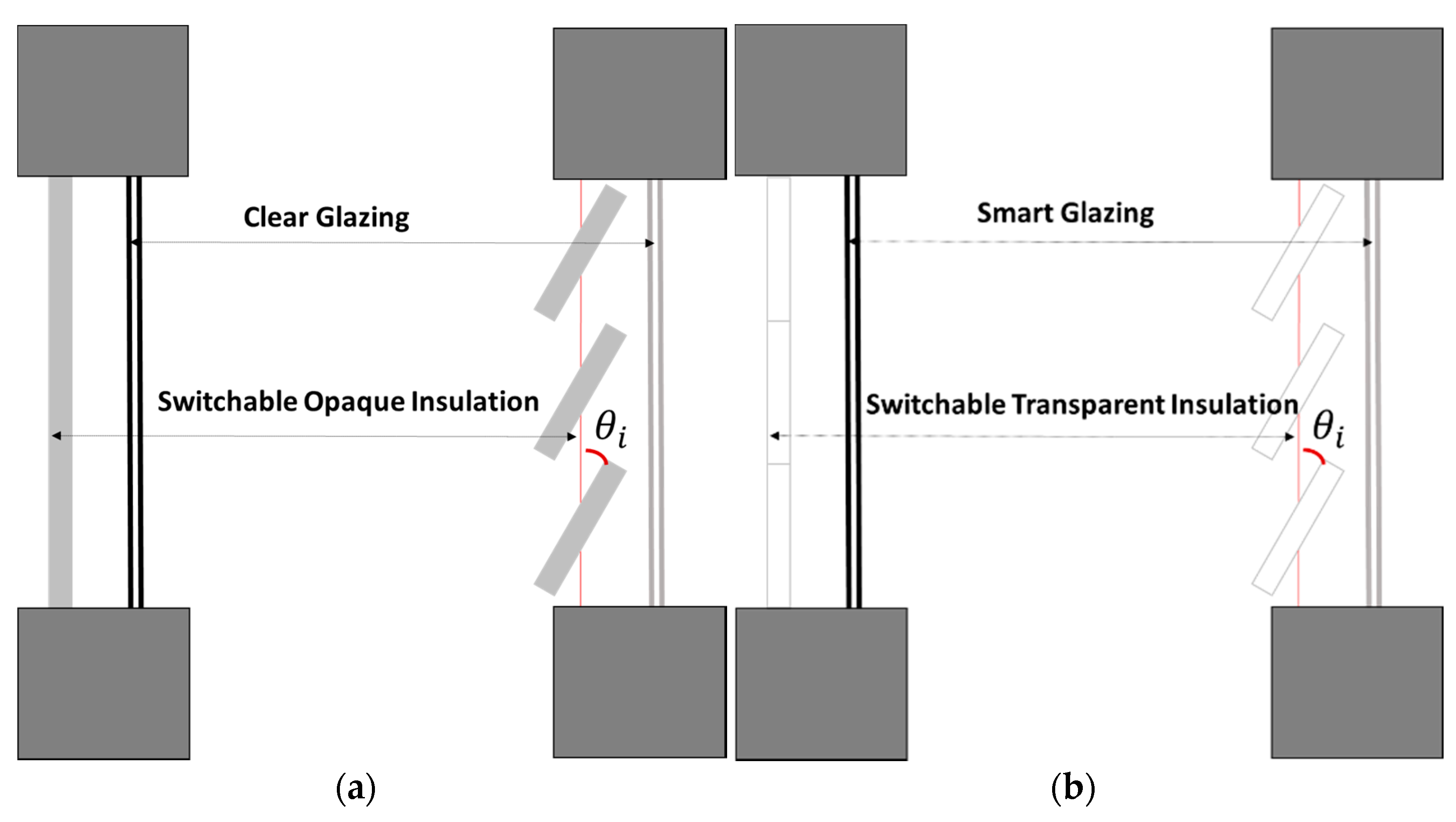

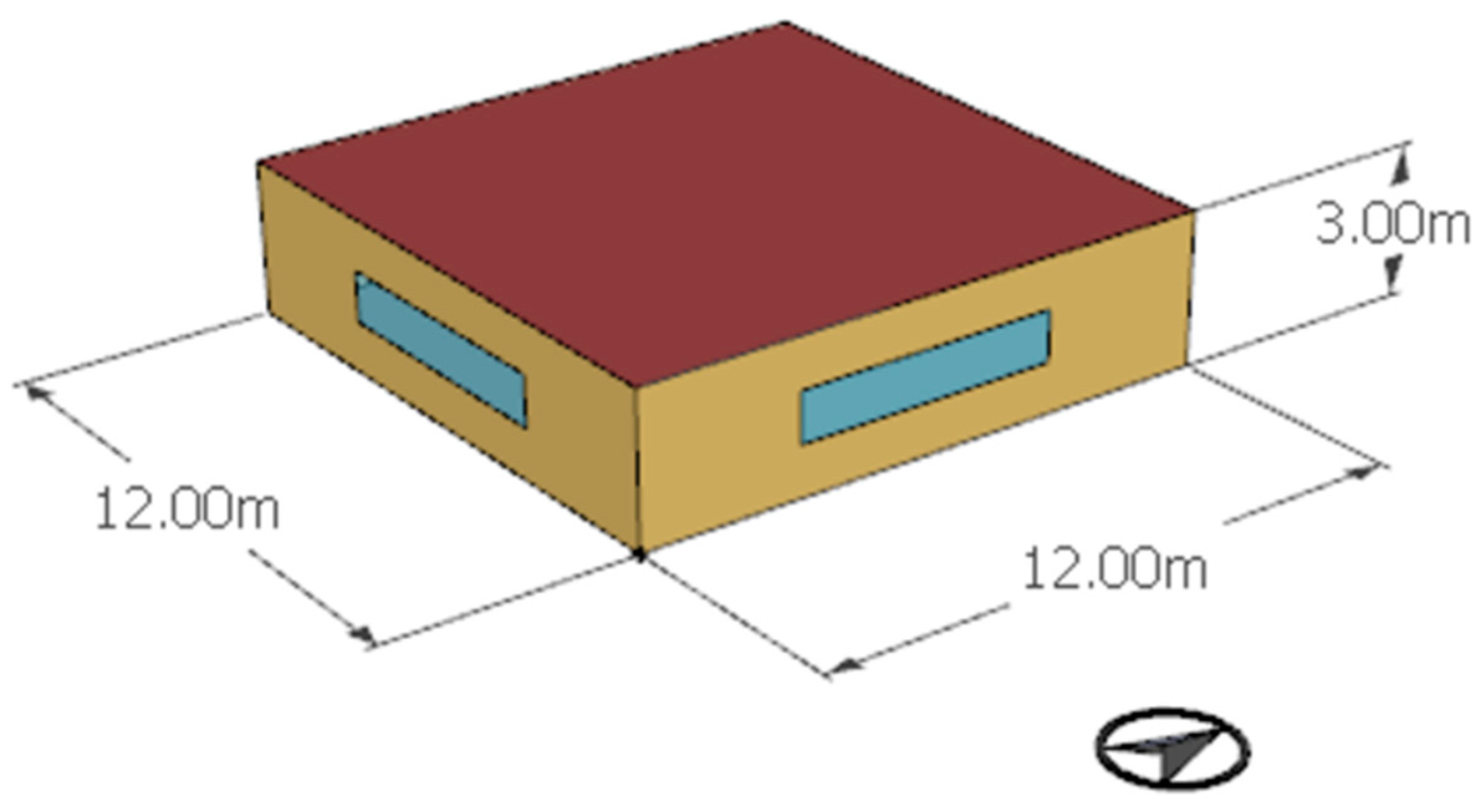
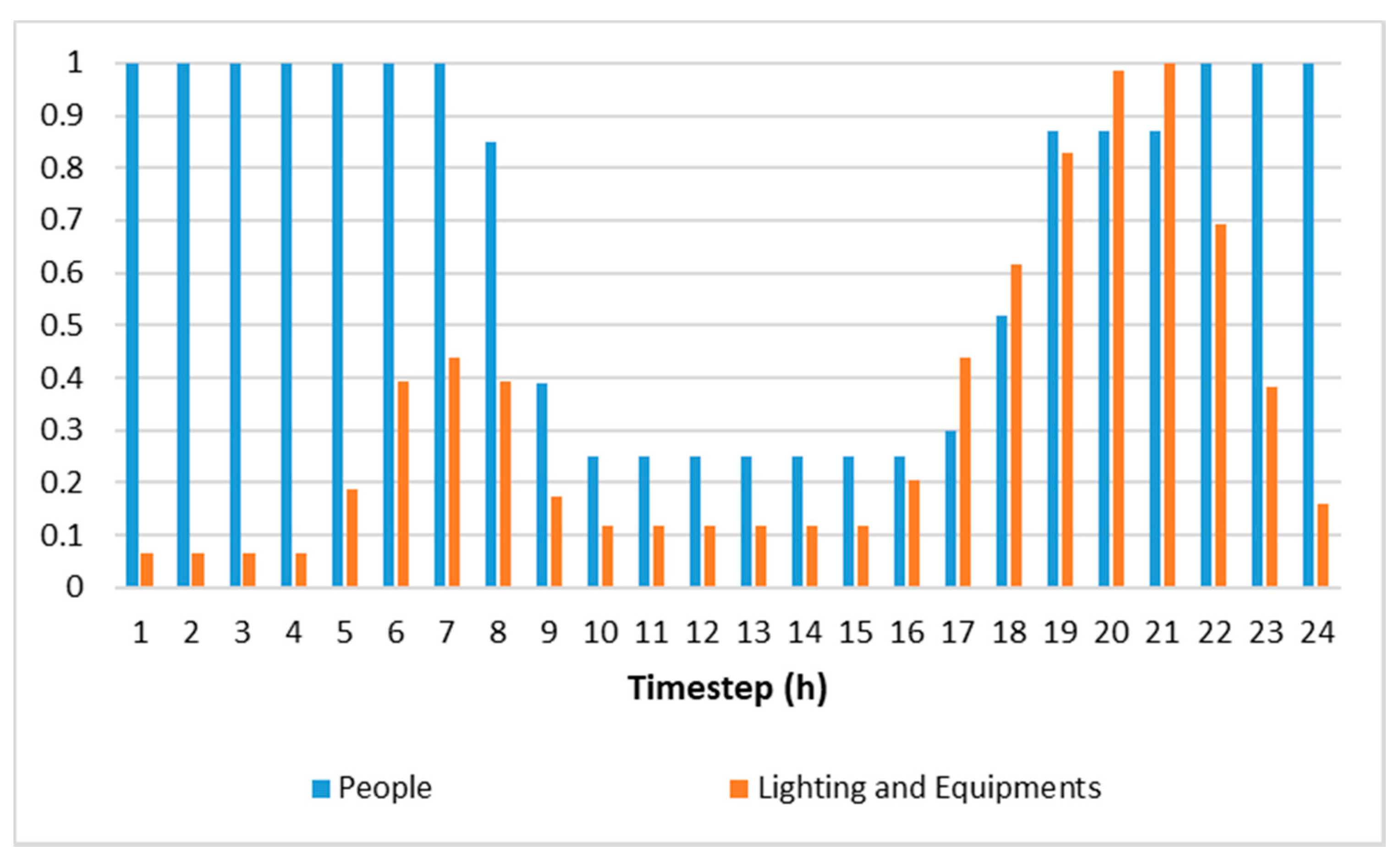




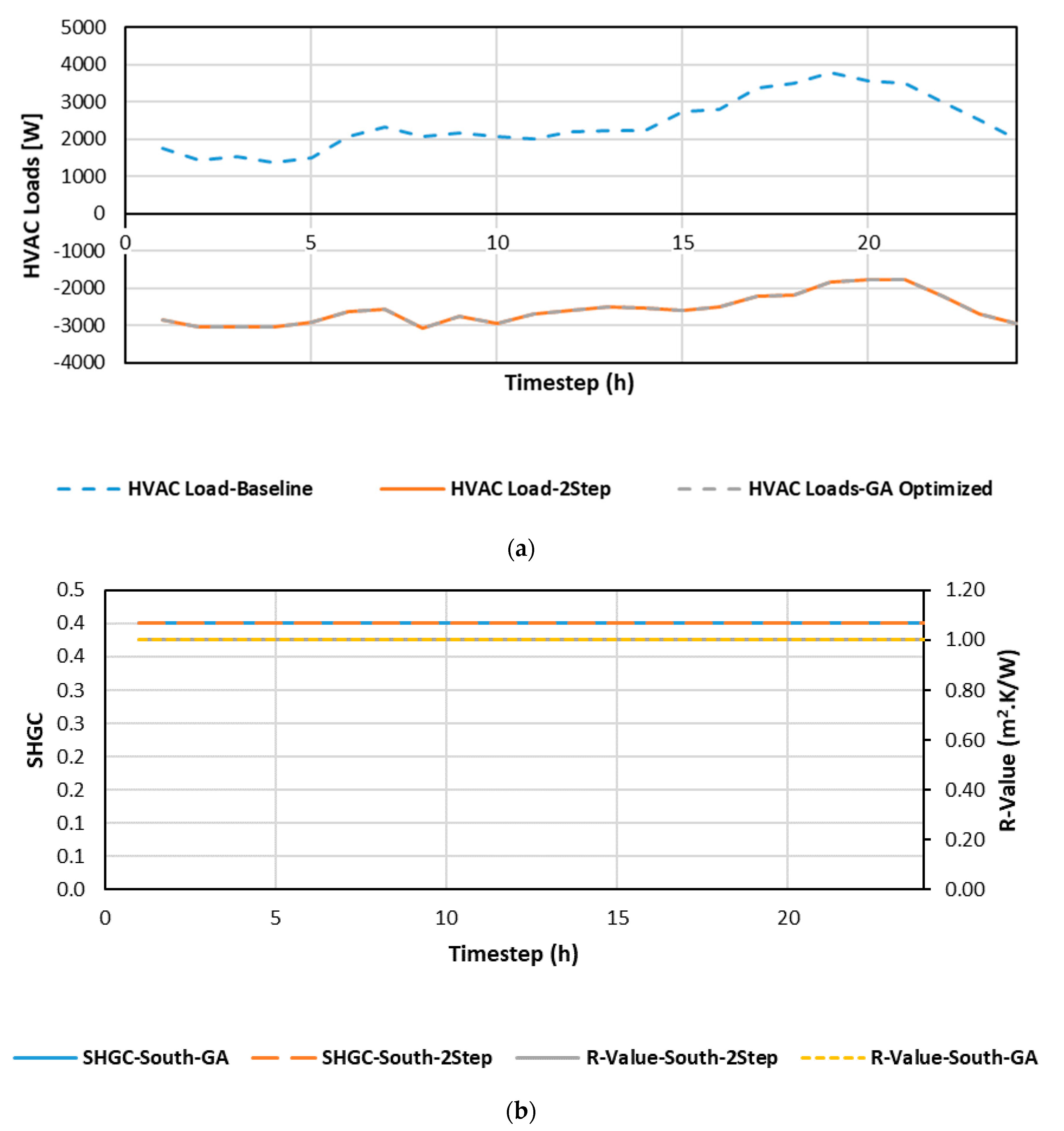
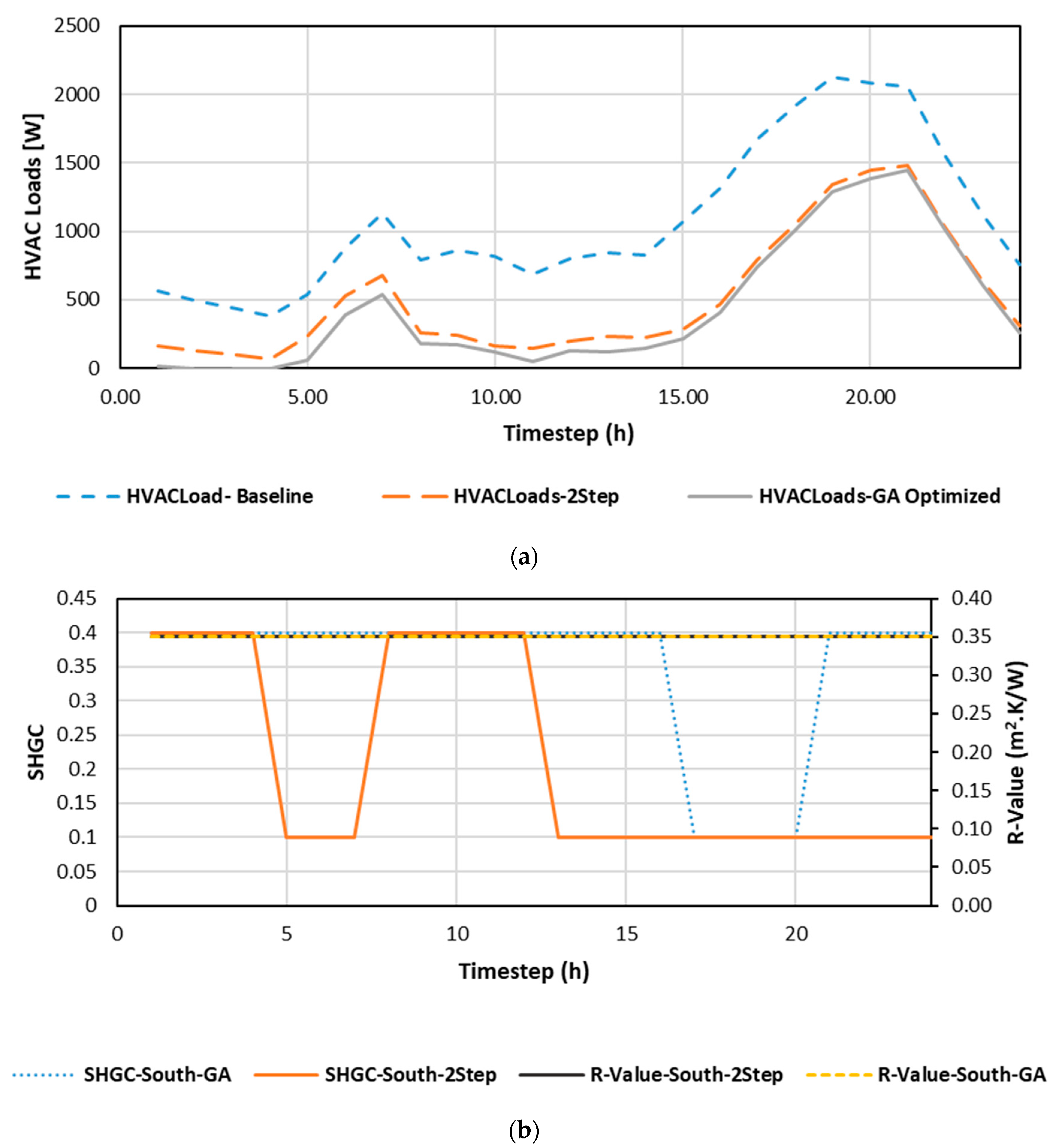


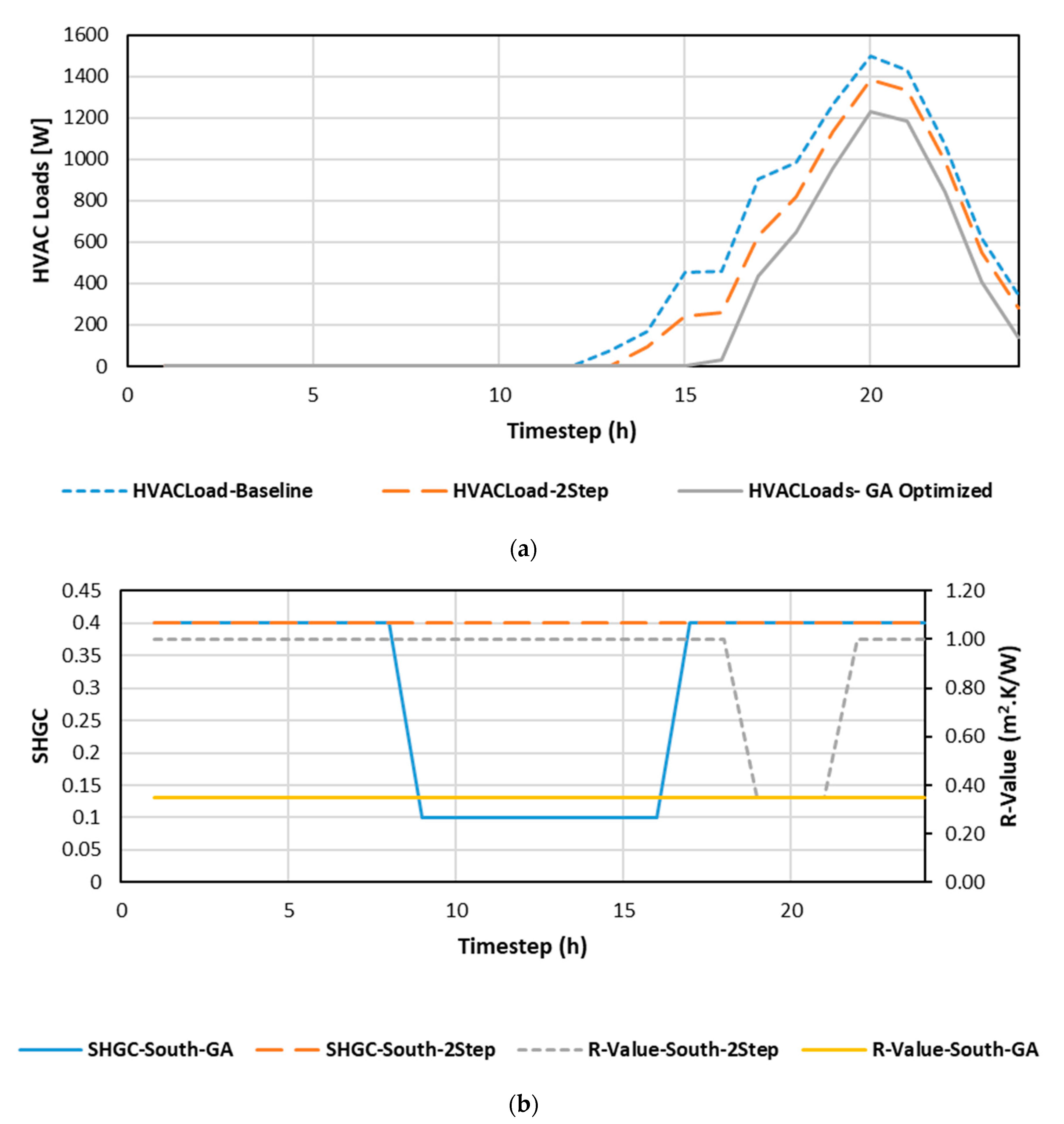
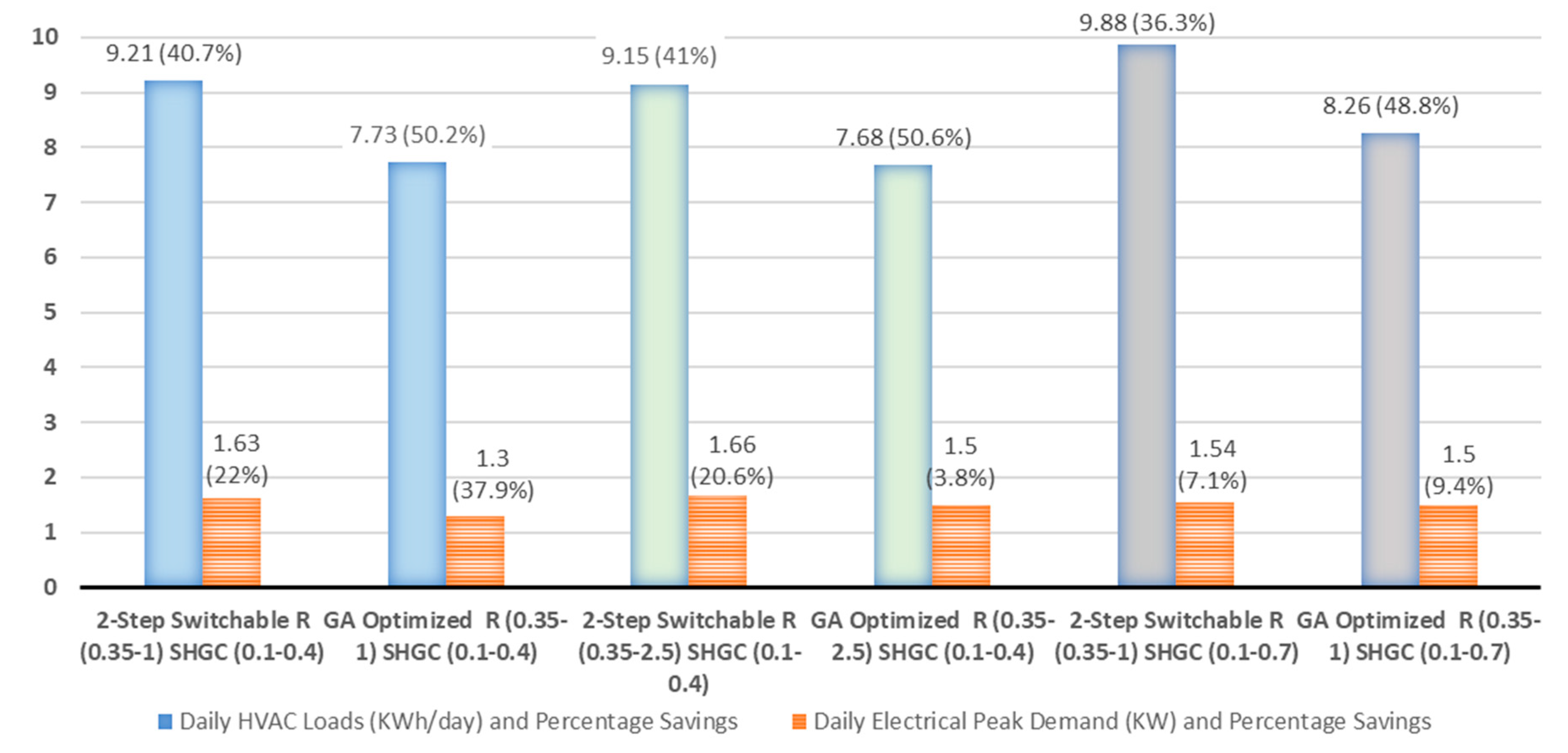

| Building Characteristics | Detached |
|---|---|
| Orientation | South |
| Floor to Ceiling Height | 3 m |
| Floor Area | 144 m2 |
| Window Wall Ratio | 15% |
| Windows | Double-glazed wooden window RSI: 0.35 SHGC: 0.4 Window to Wall Ratio: 15% |
| Floor | Adiabatic |
| Wall | RSI-2.3 (brick, rigid insulation, gypsum Board, plaster) |
| Roof | RSI-3.5 (HW concrete, rigid Insulation, membrane, plaster) |
| Heating Operation | Period: 1 October–30 April: Temperature Set point: 19 °C |
| Cooling Operation | Period: 1 May–30 September Temperature Set point: 23 °C |
| Heating and Cooling System | Heating: Gas-Fire Furnace Efficiency: 95% Cooling: Split Air Conditioner COP 3.8 (EER: 13) [55] |
| Internal Loads | People Power Density: 72 m2/person Lighting Power Density: 6 W/m2 Equipment Power Density: 3 W/m2 Air Infiltration = 5 air change per hour |
| Window Property | Baseline | Lower Boundary | Higher Boundary |
|---|---|---|---|
| R-Value (RSI) | 0.34 | 0.35 | 1 |
| SHGC | 0.4 | 0.1 | 0.4 |
| Daily HVAC Loads (KWh/Day) and Percentage Savings | |||
|---|---|---|---|
| 21 May | 13 July | 18 December | |
| Baseline | 15.53 | 57.61 | −76.71 |
| 2-Step | 9.21 | 41.22 | −61.95 |
| GA | 7.73 | 41.03 | −61.95 |
| Energy-Saving GA Compared to Baseline | 50% | 28.8% | 28.8% |
| Energy-Saving GA Compared to 2-Step | 16% | 0.5% | 0.5% |
| Electrical Peak Demand (kW) and Percentage Savings | |||
|---|---|---|---|
| 21 May | 13 July | 18 December | |
| Peak Load—Baseline | 2.09 | 3.98 | 0.21 |
| Peak Load—2-Step | 1.63 | 3.08 | 0.21 |
| Peak Load—GA | 1.51 | 3.07 | 0.21 |
| Peak Energy Saving GA Compared to Baseline | 27.8% | 22.9% | 0% |
| Peak Energy Saving GA Compared to 2-Step | 7.6% | 0.3% | 0% |
| City | Golden, CO, USA | San Francisco, CA, USA | Phoenix, AZ, USA | Chicago, IL, USA |
|---|---|---|---|---|
| CDD (based on 18 °C) | 460 | 116 | 2625 | 505 |
| HDD (based on 18 °C) | 3391 | 1403 | 593 | 3596 |
| Climate Type | 5B (Cold) | 3C (Marine) | 2B (Hot-Dry) | 5A (Cold) |
| Average Dry-Bulb Temperature (°C) | 9.3 | 13.3 | 23.1 | 9.7 |
| Köppen Climate Classification [61,62] | Dfb | Csb | Bwh | Dfa |
| Daily HVAC Loads (kWh/Day) and Percentage Savings | ||||||
|---|---|---|---|---|---|---|
| 21 May | 13 July | 18 December | 11 May | 10 July | 17 August | |
| Baseline | 12.27 | 25.72 | 0 | 20.99 | 23.26 | 15.08 |
| 2-Step | 6.69 | 12.19 | 0 | 11.07 | 10.47 | 8.26 |
| GA Optimizer | 5.81 | 10.27 | 0 | 9.84 | 10.27 | 7.26 |
| Energy Saving GA Optimizer vs. Baseline | 52.6% | 60.1% | 0 | 53.1% | 56% | 51.9% |
| Energy Saving GA Optimizer vs. 2-Step | 13.2% | 15.7% | 0 | 11.1% | 1.9% | 12.2% |
| Electrical Peak Demand (kW) and Percentage Savings | ||||||
|---|---|---|---|---|---|---|
| 21 May | 13 July | 18 December | 11 May | 10 July | 17 August | |
| Baseline | 1.61 | 2.33 | 1.29 | 2.14 | 2.31 | 1.85 |
| 2-Step | 1.39 | 1.69 | 1.29 | 1.67 | 1.68 | 1.51 |
| GA | 1.32 | 1.66 | 1.29 | 1.61 | 1.66 | 1.46 |
| Energy Saving GA Compared to Baseline | 18% | 29.1% | 0% | 2.14 | 2.31 | 1.85 |
| Energy Saving GA Compared to 2-Step | 4.9% | 2% | 0% | 1.67 | 1.68 | 1.51 |
| Daily HVAC Loads (kWh/Day) and Percentage Savings | ||||||
|---|---|---|---|---|---|---|
| 21 May | 13 July | 18 December | 10 July | 15 February | 15 November | |
| Baseline | 60.39 | 78.56 | 2.28 | 77.52 | 6.04 | 26.1 |
| 2-Step | 45.5 | 61.5 | 1.91 | 62.21 | 4.92 | 13.74 |
| GA | 44.83 | 61.17 | 0.35 | 61.6 | 3.94 | 13.38 |
| Energy Saving GA Compared to Baseline | 25.8% | 22.1% | 84.8% | 21% | 34.8% | 49% |
| Energy Saving GA Compared to 2-Step | 1.5% | 0.5% | 81.8% | 77.52 | 6.04 | 26.1 |
| Electrical Peak Demand (kW) and Percentage Savings | ||||||
|---|---|---|---|---|---|---|
| 21 May | 13 July | 18 December | 10 July | 15 February | 15 November | |
| Baseline | 4.16 | 4.61 | 0.96 | 4.44 | 1.29 | 2.33 |
| 2-Step | 3.33 | 3.92 | 0.88 | 3.85 | 1.22 | 1.85 |
| GA | 3.3 | 3.91 | 0.44 | 3.82 | 1.12 | 1.82 |
| Energy Saving GA Compared to Baseline | 20.7% | 15.1% | 53.8% | 14% | 13.6% | 22% |
| Energy Saving GA Compared to 2-Step | 1.1% | 0.1% | 49.8% | 0.9% | 8.8% | 1.5% |
| Daily HVAC Loads (kWh/Day) and Percentage Savings | ||||||
|---|---|---|---|---|---|---|
| 21 May | 13 July | 18 December | 1 July | 19 September | 14 April | |
| Baseline | 23.32 | 37.52 | −55.47 | 26.61 | −12.62 | −9.27 |
| 2-Step | 12.55 | 27.06 | −43.93 | 17.28 | −7.26 | −7.73 |
| GA | 12.32 | 26.76 | −43.93 | 16.91 | −6.16 | −5.88 |
| Energy Saving GA Compared to Baseline | 47.2% | 28.7% | 19.7% | 36.4% | 51.2% | 36.6% |
| Energy Saving GA Compared to 2-Step | 1.9% | 1.1% | 0% | 2.1% | 15.1% | 23.9% |
| Electrical Peak Demand (kW) and Percentage Savings | ||||||
|---|---|---|---|---|---|---|
| 21 May | 13 July | 18 December | 1 July | 19 September | 14 April | |
| Baseline | 2.41 | 2.93 | 0.21 | 2.14 | 1.65 | 1.7 |
| 2-Step | 1.9 | 2.41 | 0.21 | 1.81 | 1.46 | 1.59 |
| GA | 1.88 | 2.39 | 0.21 | 1.78 | 1.39 | 1.44 |
| Energy Saving GA Compared to Baseline | 21.8% | 18.7% | 0% | 17% | 15.6% | 15.7% |
| Energy Saving GA Compared to 2-Step | 1% | 1% | 0% | 1.5% | 4.7% | 9.9% |
| Daily HVAC Loads (kWh/Day) and Percentage Savings | |||||
|---|---|---|---|---|---|
| Baseline | 2-Step Switchable | GA Optimized 1-h Timestep | GA Optimized 4-h Timestep | GA Optimized 8-h Timestep | |
| HVAC Loads | 15.53 | 9.21 | 7.70 | 7.73 | 7.77 |
| Savings Compared to Baseline | 0% | 40.74% | 50.4% | 50.2% | 49.9% |
| Processing Time * | 0.3 h | 0.3 h | 10.4 h | 3.5 h | 1 h |
| Daily HVAC Loads (kWh/Day) and Percentage Savings | |||||
|---|---|---|---|---|---|
| Baseline | 2-Step Switchable both R-Value and SHGC | GA Optimized -Population Size: 50 | GA Optimized -Population Size: 100 | GA Optimized-Population Size: 200 | |
| HVAC Loads | 15.53 | 9.21 | 7.73 | 7.74 | 7.79 |
| Savings Compared to Baseline | 0% | 40.74% | 50.4% | 50.4% | 49.8% |
| Processing Time * | 0.3 h | 0.3 h | 3.5 h | 5.9 h | 10.7 h |
| Daily HVAC Loads (kWh/Day) & Electrical Peak Demand (kW) and Percentage Saving | ||||||
|---|---|---|---|---|---|---|
| Baseline (with Internal Loads) | 2-Step Switchable (with Internal Loads) | GA Optimized (with Internal Loads) | Baseline (without Internal Loads) | 2-Step Switchable (without Internal Loads) | GA Optimized (without Internal Loads) | |
| HVAC Loads | 22.43 (0%) | 11.17 (50.2%) | 9.74 (56.6%) | 8.76 (0%) | 2.31 (73.7%) | 0.62 (93%) |
| Electrical Peak Demand | 2.33 (0%) | 1.76 (24.5%) | 1.68 (27.8%) | 1.11 (0%) | 0.36 (67.3%) | 0.19 (82.9%) |
Publisher’s Note: MDPI stays neutral with regard to jurisdictional claims in published maps and institutional affiliations. |
© 2021 by the authors. Licensee MDPI, Basel, Switzerland. This article is an open access article distributed under the terms and conditions of the Creative Commons Attribution (CC BY) license (https://creativecommons.org/licenses/by/4.0/).
Share and Cite
Dabbagh, M.; Krarti, M. Optimal Control Strategies for Switchable Transparent Insulation Systems Applied to Smart Windows for US Residential Buildings. Energies 2021, 14, 2917. https://doi.org/10.3390/en14102917
Dabbagh M, Krarti M. Optimal Control Strategies for Switchable Transparent Insulation Systems Applied to Smart Windows for US Residential Buildings. Energies. 2021; 14(10):2917. https://doi.org/10.3390/en14102917
Chicago/Turabian StyleDabbagh, Mohammad, and Moncef Krarti. 2021. "Optimal Control Strategies for Switchable Transparent Insulation Systems Applied to Smart Windows for US Residential Buildings" Energies 14, no. 10: 2917. https://doi.org/10.3390/en14102917
APA StyleDabbagh, M., & Krarti, M. (2021). Optimal Control Strategies for Switchable Transparent Insulation Systems Applied to Smart Windows for US Residential Buildings. Energies, 14(10), 2917. https://doi.org/10.3390/en14102917





